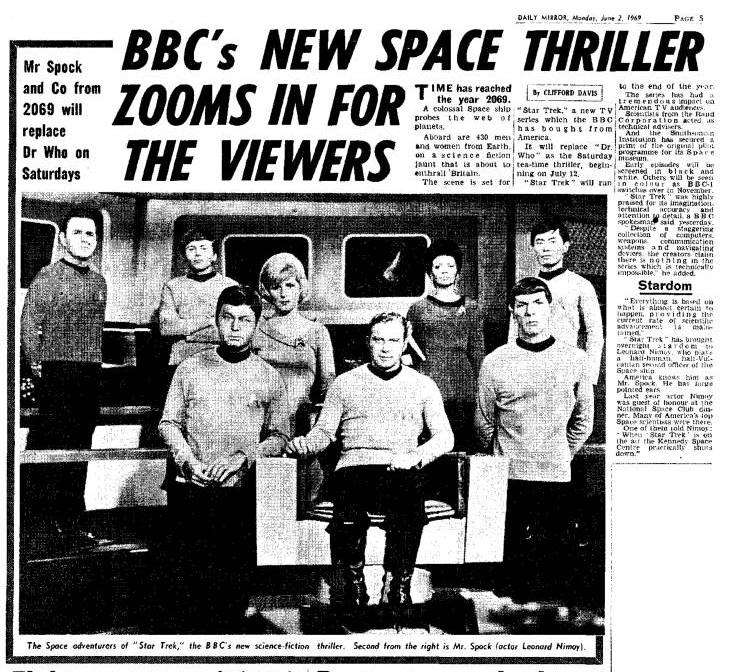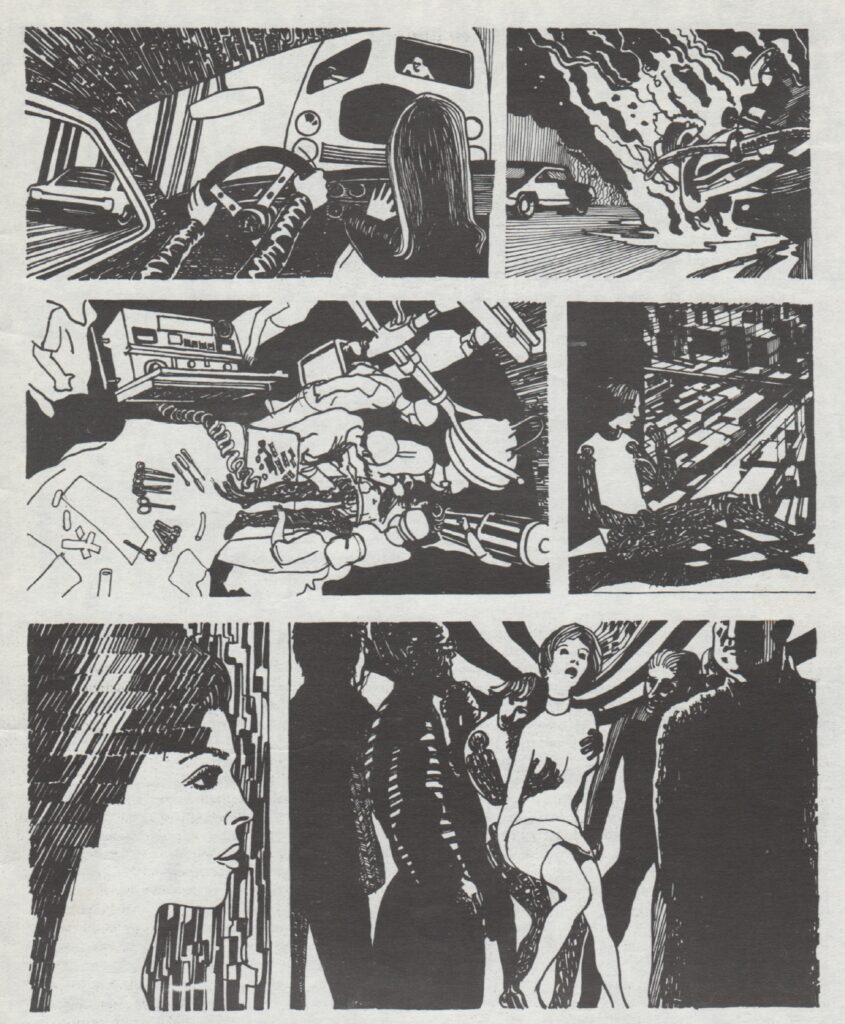
by Mark Yon
Scenes from England
Hello again!
As we are now into Summer here, the warmer weather leads to reflection, if not introspection, although I am quite excited about the next few months. Not only do we have the impending Apollo mission to land men on the Moon – and how exciting does that sound! – but as I mentioned last month we also have Star Trek starting on the BBC in July. Such news even reached the national newspapers here.

The only annoying part of that last event is that I understand that the Beeb will not show all of them but a selection, chosen from all three seasons. I hope I’m wrong, but as the series is filling in time between July and new Doctor Who in the Autumn, it sounds likely.
More positively, though, and partly based on the comments from my colleagues here at Galactic Journey, I feel that seeing any Star Trek at all has to be good. I’m just pleased that we will have chance to see them here, albeit in black and white – no colour telly luxury for me, I’m afraid. Most British viewers do not have colour televisions.
Anyway, back to New Worlds, issue 192.
 Cover by Mal Dean
Cover by Mal Dean
Another great cover by Mal Dean – that’s two in a row. This one is illustrating Norman Spinrad’s story, The Last Hurrah of the Golden Horde.
Lead-In by The Publishers
It's not just me that's in a reflective mood this month – this Lead In points out that the magazine has been five years in its current format and brings us up to date with what’s been happening to the magazine over that time: financial worries, subscription issues, publisher issues and the refusal of certain shops to sell the magazine in public.
It’s a sobering read and yet in the end a positive one, celebrating that the magazine has lasted five years in its current format and with its new agenda.
Coincidentally, this introduction also tells us that Norman Spinrad is now a resident here in Britain, which may or may not be in part due to the publication of Bug Jack Barron in this magazine.
The Garden of Delights by Langdon Jones
 Photo by Gabi Nasemann
Photo by Gabi Nasemann
This may be one of the best Langdon Jones stories I’ve read. It’s not for the easily shocked – as is de rigueur for New Worlds. It’s sexually graphic and basically deals with the story of an incestuous relationship between a boy and his mother. I liked the time travel aspect of the story, although it’s not a new science-fiction thing. 4 out of 5.
The Last Hurrah of the Golden Horde by Norman Spinrad
 Drawing by Mal Dean
Drawing by Mal Dean
Wherein Spinrad is the latest author to write about Mike Moorcock’s Jerry Cornelius. (The last was Brian W. Aldiss in last month’s issue.) The Beatles, Russians, Mongolians, a facsimile of Las Vegas in China. Chaotic and satirical (what would you expect from the author of Bug Jack Barron? Not a bad effort, frankly. 4 out of 5.
Erogenous Zone by Graham Charnock
 Drawing by Mal Dean
Drawing by Mal Dean
The fourth story based in Graham’s world, CRIM – the first was in New Worlds in November 1965, the third last month. It’s a strange world, where advertising is an essential part of society. It’s a two-act story, one where Craven Image (great name! – but also not-coincidentally ‘CR…IM’) is in a car accident and taken to the hospital afterwards, and another where a dying man is being watched by his daughter and her spouse. Not a story to make sense, but lots of vivid imagery and sex. The world is both odd and depressing, with talk of the Dresden bombings, amongst other things. I’m reminded of Kurt Vonnegut’s Slaughterhouse 5 a little, although not quite as ‘out there’ as that. 3 out of 5.
Article: The Shape of Further Things by Brian W. Aldiss
 Unknown source.
Unknown source.
A non-fiction article from Mr. Aldiss, with the promise of more to follow at a later date. It is written more as a monologue, combining Aldiss’s own life with ruminations of life, technology and H. G. Wells. Odd, but engaging. 4 out of 5.
Surface If You Can by T. Champagne
 Drawing by Mal Dean
Drawing by Mal Dean
According to the Lead In, Terry Champagne is a sculptor and an author. Her first story here in Britain is about a young couple who rent a fallout shelter as a home, only to find themselves sealed in when what appears to be nuclear bombs fall outside. A surprisingly straightforward story, with a twist at the end, given the New Worlds treatment by including lots of sex and even necrophilia. There’s also cockroaches. 4 out of 5.
Circularisation by Michael Butterworth

And here’s this issue’s attempt to break down traditional prose format by creating a number of ‘radial-planographic condensed word image structures’, rotated around a point. As these things go, I quite liked the concept of these, although I disliked the fact that the author felt he had to explain them for pages at the end. The actual content is symbolic nonsense, of course. 3 out of 5.
An Experiment in Genocide by Leo Zorin
 Artist drawings are unlabelled, but possibly by Mal Dean
Artist drawings are unlabelled, but possibly by Mal Dean
Leo Zorin’s odd snippets of prose seem to be well-liked by New Worlds readers (or is that editors?) I’m less impressed by most, although this one was more accessible. This one’s about a pervert (actually described as such in the text!) wandering a world of Ballardian car accidents and grotesque characters that feel like they’ve mutated from Moorcock’s world of Elric. More visual, mixed-up imagery as a result. 3 out of 5.
Perjoriative by Robert E. Toomey Jr.
A story that begins with a one-armed man and a dwarf on a bus and ends with a mushroom cloud. A typical New Worlds story of oddness, reminiscent of the rant-y elements of Bug Jack Barron. 3 out of 5.
Book Reviews: Terrible Biological Haste by Kenneth Coutts-Smith
 Where Kenneth Coutts-Smith looks at the work of artist Aubrey Beardsley.
Where Kenneth Coutts-Smith looks at the work of artist Aubrey Beardsley.
Book Reviews: Fourteen Shillings Worth of Grass by R. G. Meadley
R. G. Meadley reviews Gunter Grass’s Dog Years as well as a book of his poetry.
Book Reviews: Paperbag by Joyce Churchill
Joyce Churchill (also known as M. John Harrison) reviews some science fiction books, including Edmund Cooper’s “dated” Deadly Image, Anne McCaffrey’s Decision at Doona (from “the Enid Blyton of science fiction”), Michael Frayn’s satire The Tin Men, John Jakes’s The Planet Wizard, M. P. Shiel’s The Purple Cloud and (unsurprisingly) saves the plaudits for Norman Spinrad’s Bug Jack Barron, lastly taking a pop at the editor of Ace Books, Donald A. Wollheim, with a quote from his review of Bug Jack Barron;

Book Reviews: The Sexual Gothic Private Eye Caper by Charles Platt
Charles Platt reviews The Image of the Beast by Philip Jose Farmer very positively.
Book Reviews: The Quality of Justice by David Conway
Back to the non-genre stuff. David Conway reviews a philosophical book on the quality and justice of our social practices.
Summing up New Worlds
I was surprised and pleased to find that on balance I enjoyed this more than the last issue. Spinrad makes a decent stab of a Jerry Cornelius story, the Langdon Jones is acceptable (a fairly standard science fiction idea given the New Worlds treatment of sex and incest) and some good work from new writers as well. I even found the poetry less annoying than usual, although I readily accept that I was more interested in the process of creating rather than the content of the poetry.
What was most memorable however was the fighting talk given by the editors at end of the Lead In at the beginning of the issue. As shown here, New Worlds has not been without its difficulties over the past five years, but based on this it looks like it is determined to fight for its place in a literary market.

Anyway, that’s it, until next time.


![[June 26, 1969] <i>Five Years… New Worlds</i>, July 1969](https://galacticjourney.org/wp-content/uploads/2024/06/new-worlds-july-1969-672x372.jpg)
